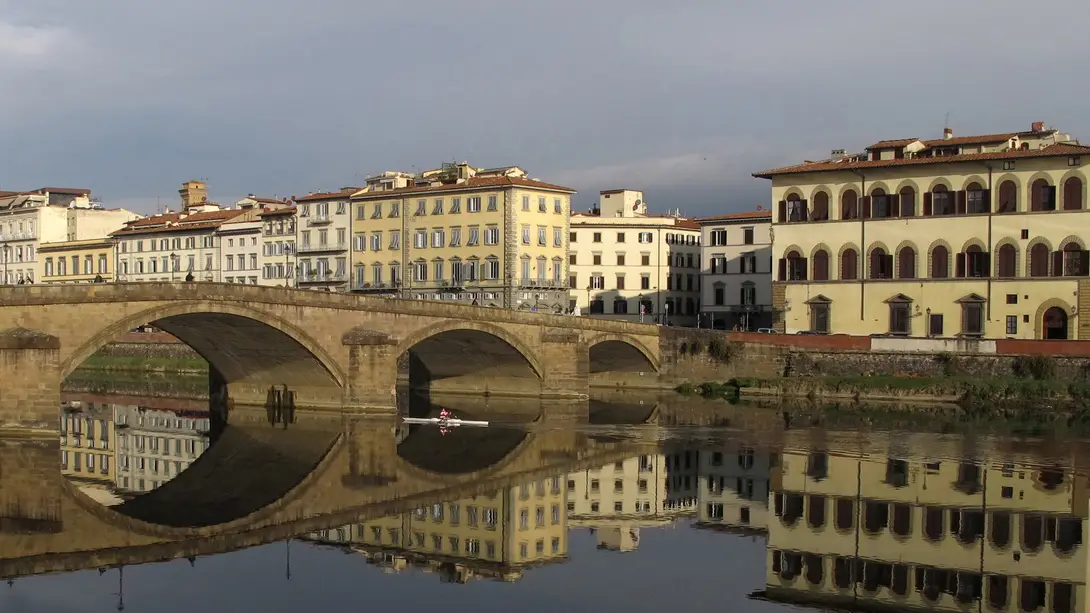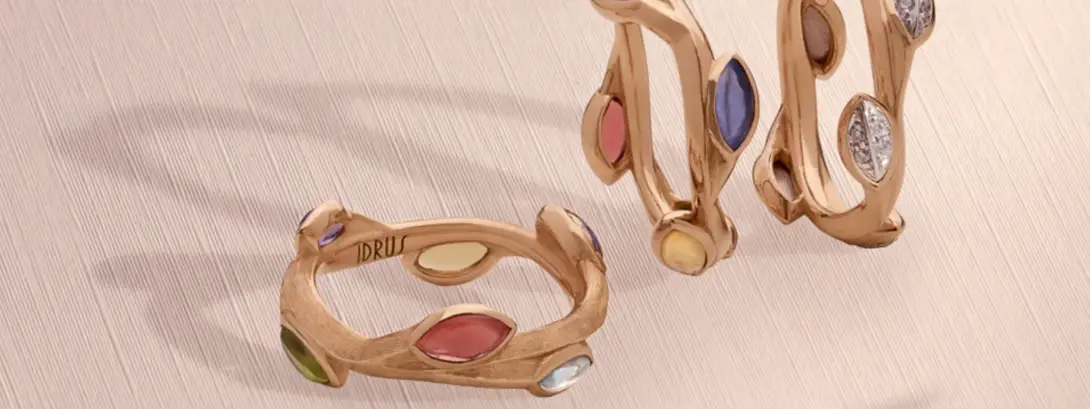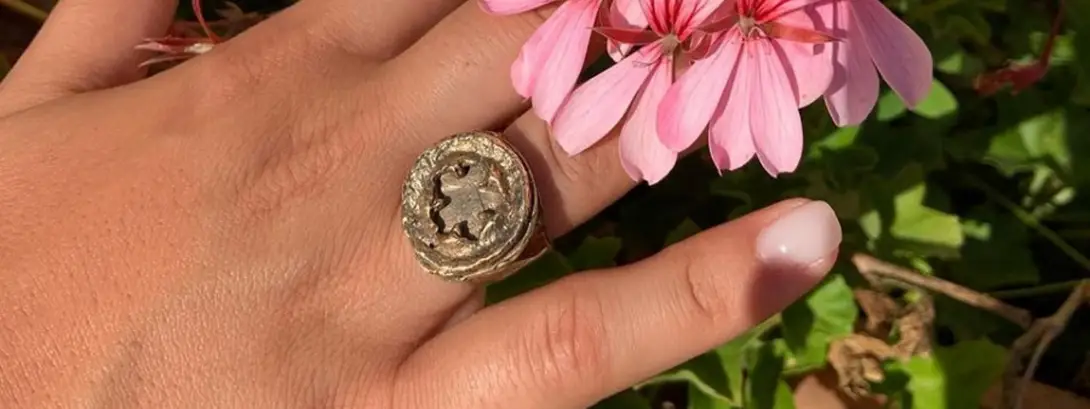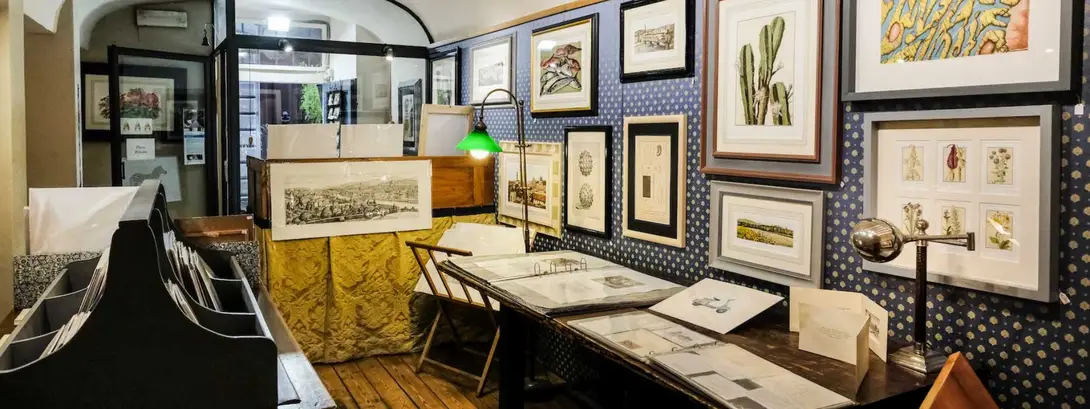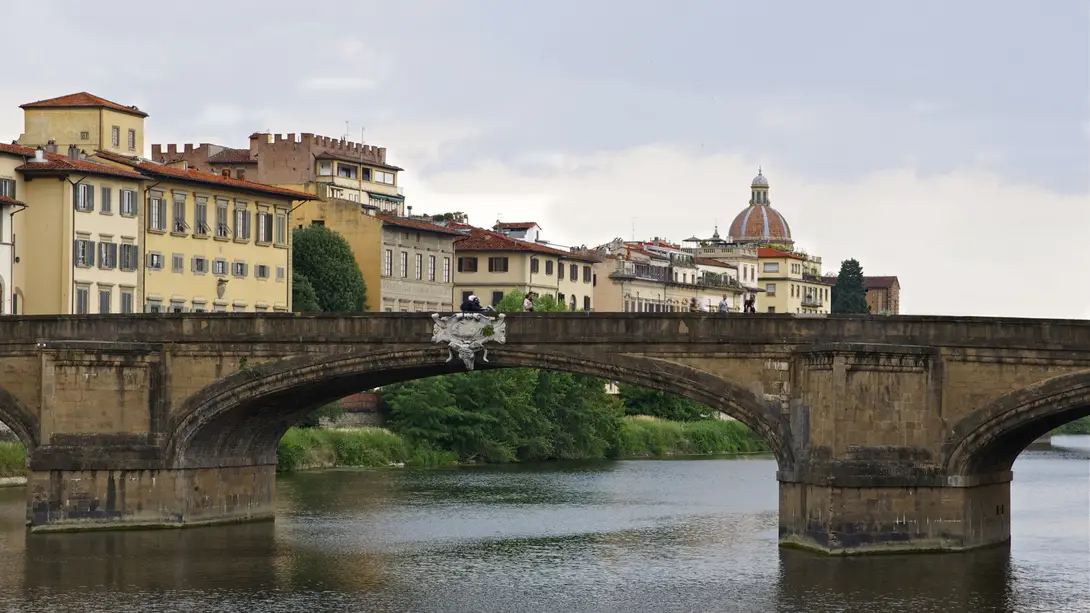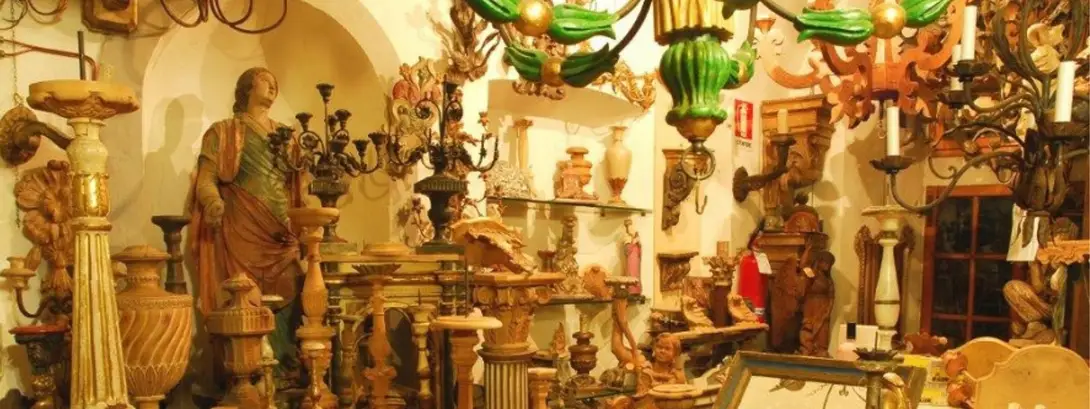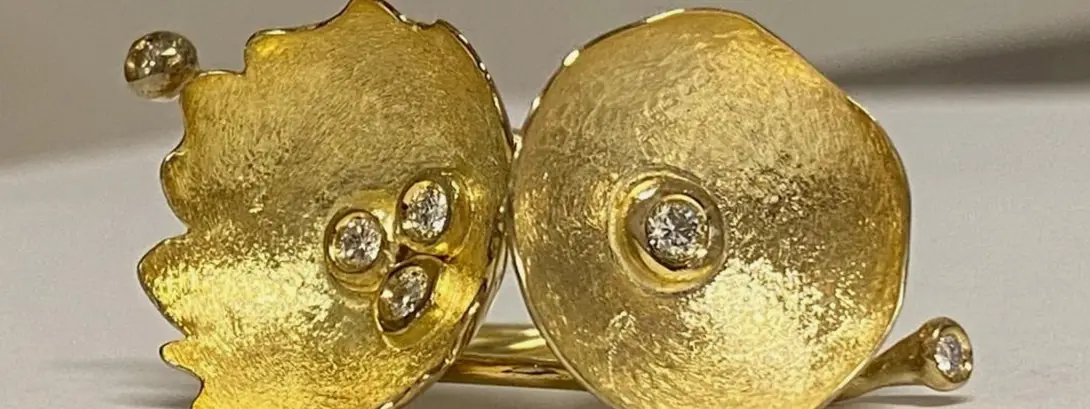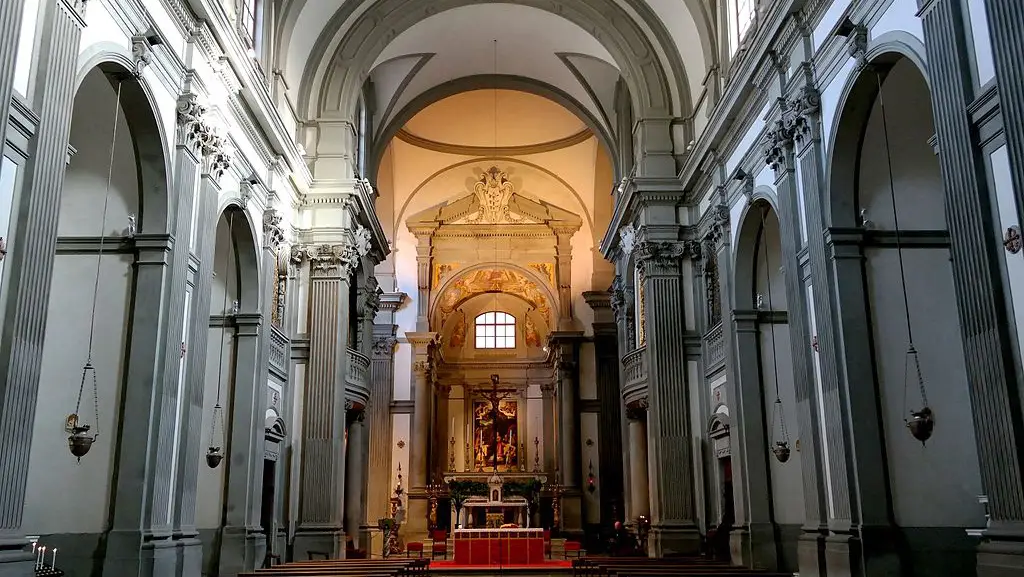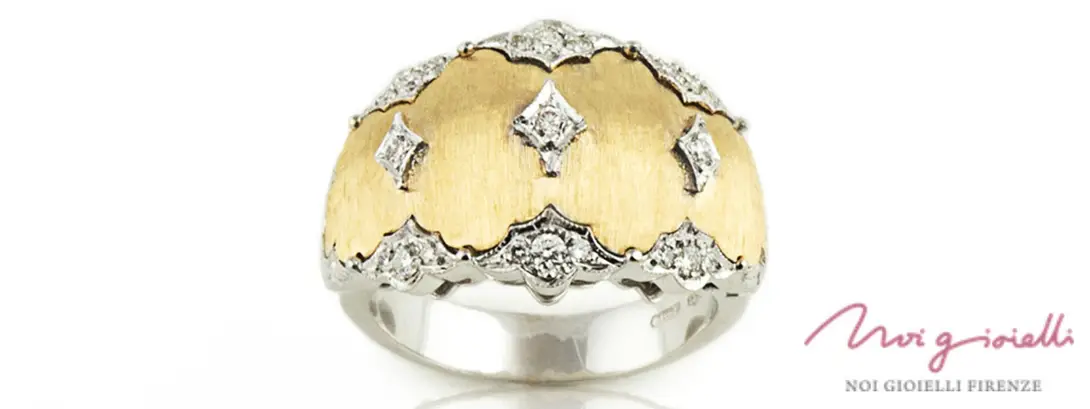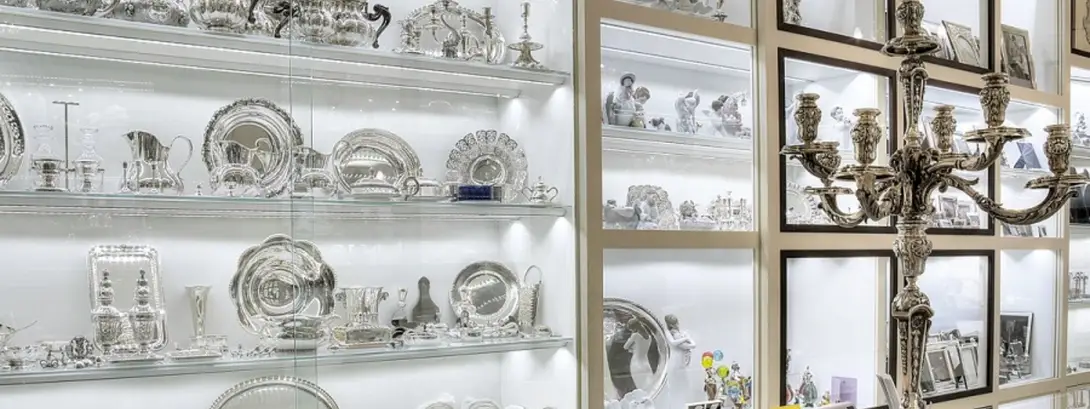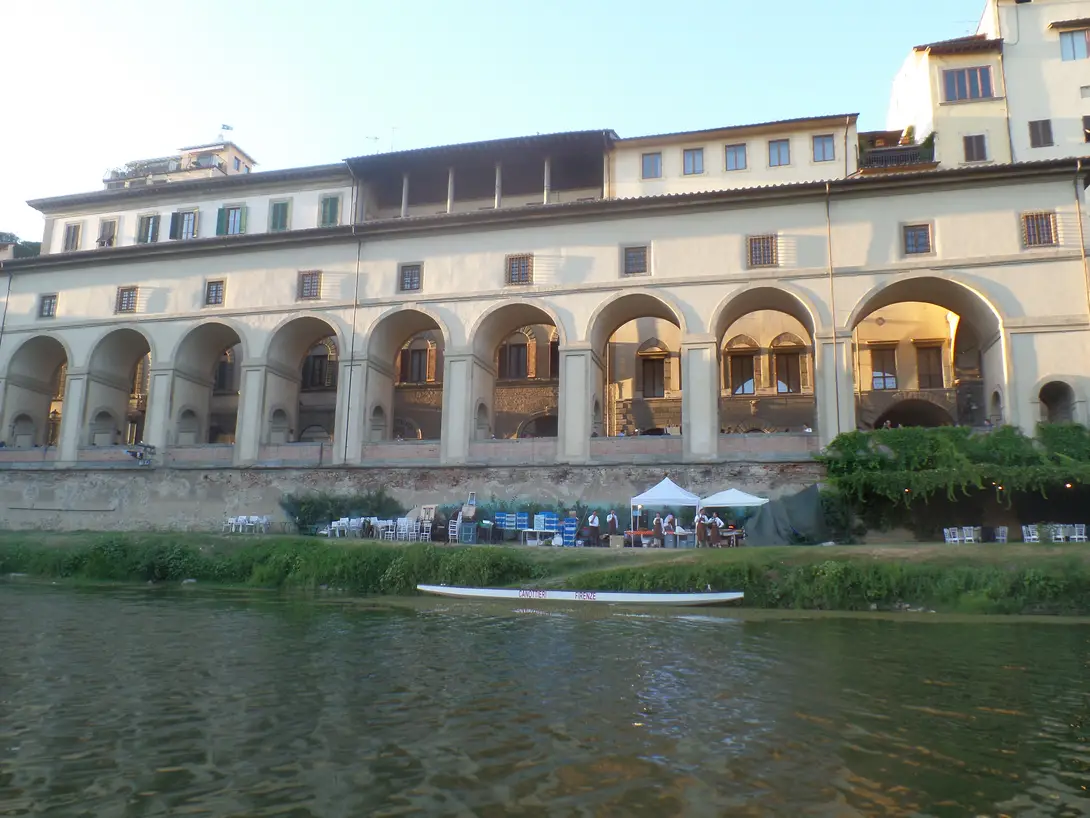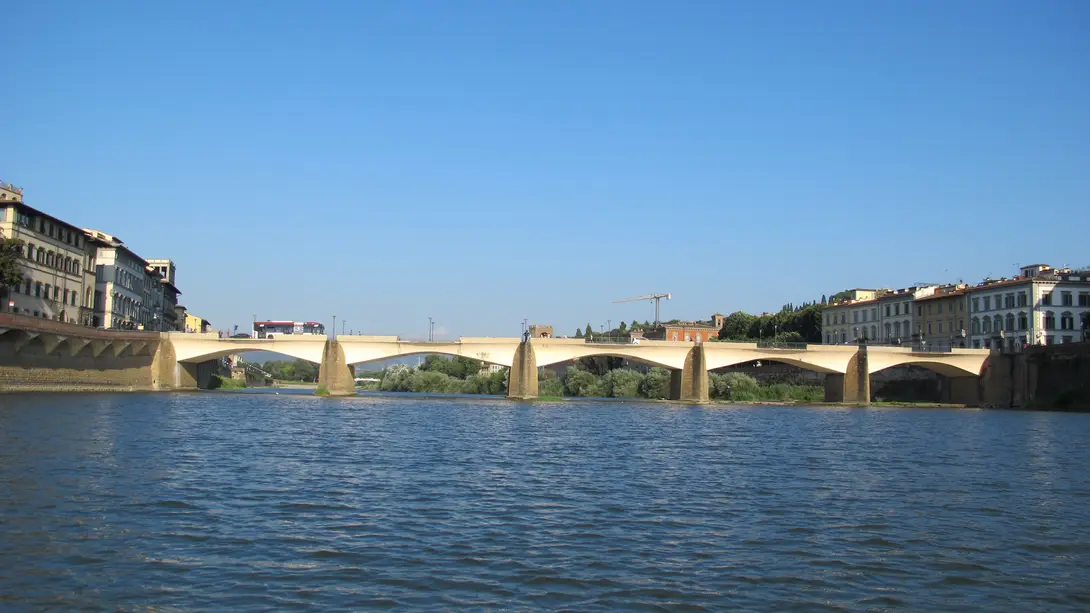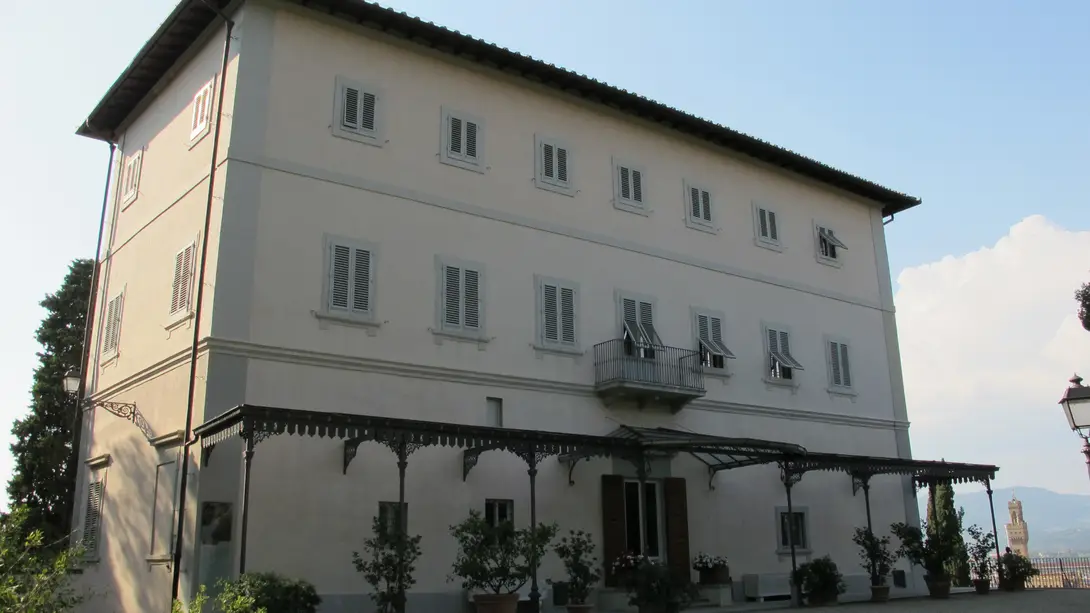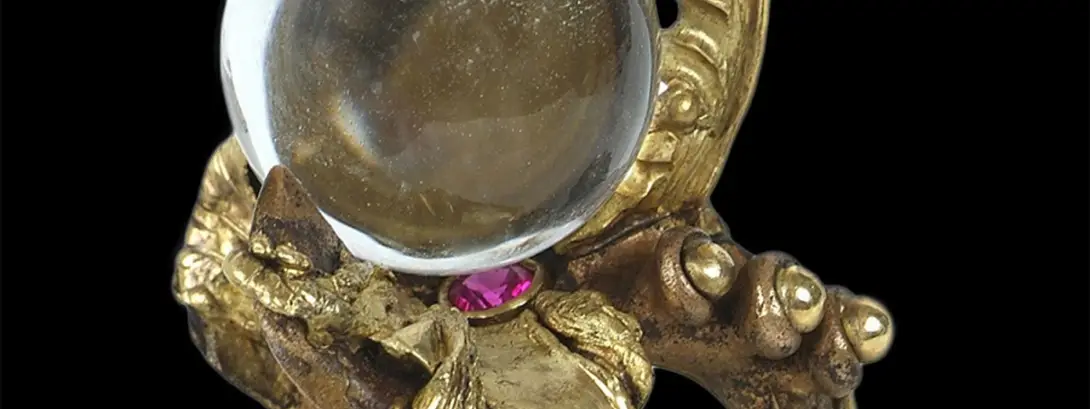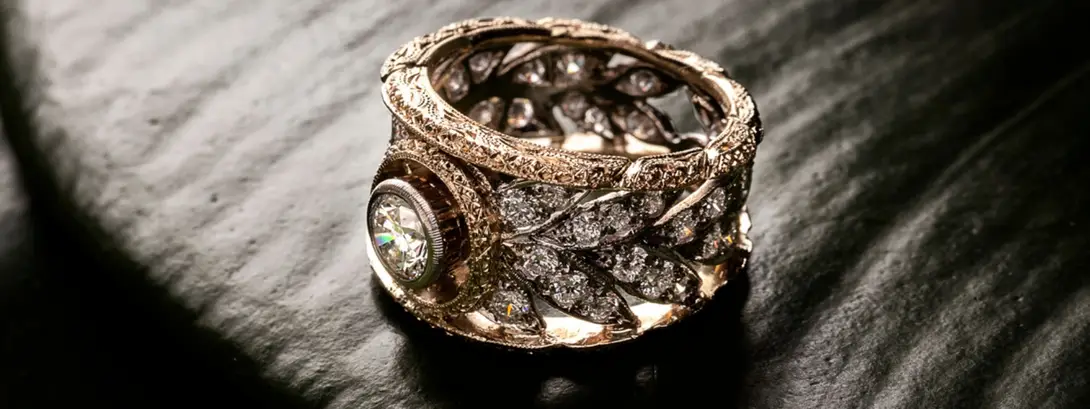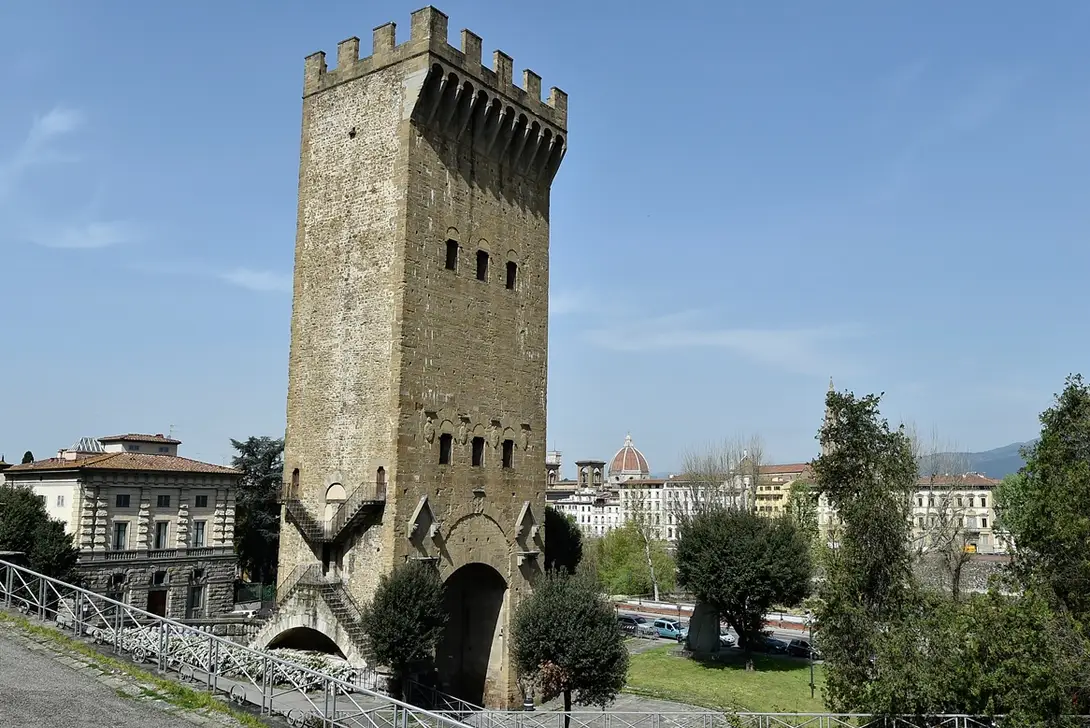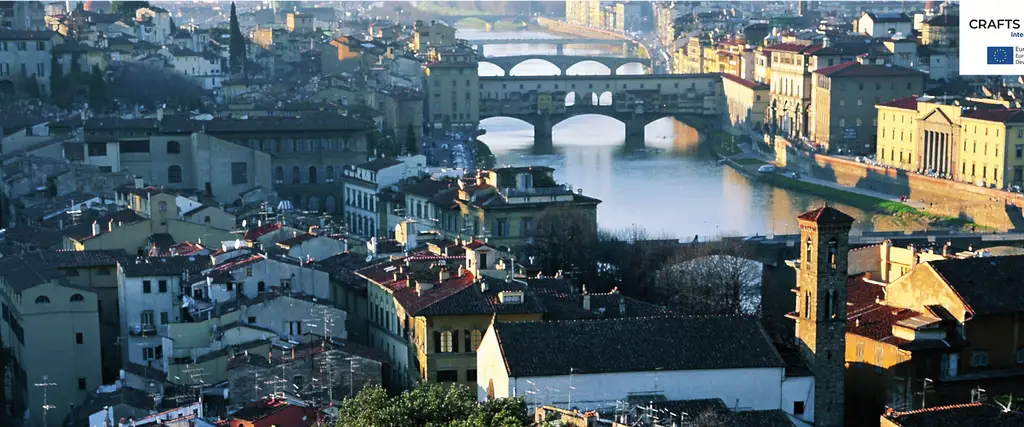
The left bank of the Arno
A jubilation of trades, a florilegium of artisan workshops characterises this itinerary that unfolds in a few hundred metres along the rive gauche of the Arno, between Ponte alla Carraia and Ponte alle Grazie, in the beating heart of the creative Florentine Oltrarno.
The itinerary will take you on a discovery of historical and artistic masterpieces and artisan workshops, showing the creative vitality that has characterised this area over the centuries, and that still amazes today. From jewellery to the art of wood and decoration, from engraving techniques to silver work, 10 realities marked by the artistic-architectural marvels of the bridges over the Arno and all that is adjacent, the Bardini area, the Vasariano, the Santo Spirito district.
This itinerary is created inside the European Project Crafts Code
Comune di Firenze
Les lieux
Étapes
Ponte alla Carraia
The original bridge was the second one built over the Arno after Ponte Vecchio, hence the name 'new bridge'. It was also known as the "ponte alle Carra": the work was erected at the behest of the Umiliati di Ognissanti fathers, the first Florentine wool entrepreneurs, and was used to divert wagon traffic to the homonymous city Gate of the penultimate circle of walls. Over the centuries it was rebuilt several times following the numerous floods of the Arno, but also in 1304, when it collapsed under the excessive weight of the crowd that had come to attend a show on the river. The bridge, rebuilt by Cosimo I de' Medici, lasted for about four centuries, as it was destroyed – like all others, with the only exception of Ponte Vecchio - in 1944 during the Nazi retreat. The current version dates back to 1951.
Idrus Firenze - Alessandro Barellini Jewels
Designed to be worn at all times, Alessandro Barellini's jewellery is carefully crafted following the best Italian goldsmith tradition in 18kt gold, diamonds and precious stones. Each piece of jewellery is unique, however, dominated by the metamorphosis of shapes that transform them from time to time, always giving rise to something new, unique and multiple. Clean yet complicated lines at the same time, geometric patterns that fit perfectly with the body, capturing the light with every movement.
Marina Calamai- Artist and Jewelry Designer
Marina Calamai is a Florentine artist and designer.
Inspired by nature and with the aim of creating works of art that awaken the five senses, she also uses her humour and irony to transform everyday objects into something unique, playful yet emotionally impactful, true works of art.
Marina's creativity finds a home in her multi-sensory workshop in Via Santo Spirito, where all her multimedia artistry comes together in a unique harmony.
Her works range from jewellery and furniture design to artworks and art installations dedicated to nature.
L'Ippogrifo Stampe D'Arte
In Florence, in the historical quarter of the Florentine artisans, L'Ippogrifo Stampe d'Arte has been performing the ancient etching technique for more than 40 years. Gianni Raffaelli, together with his wife Francesca and son Duccio, creates his works by manually engraving them on copper plates, then printing them on fine paper in limited editions. The prints are then hand-coloured, signed and numbered by the author and matched with handcrafted frames made according to taste and experience.
Ponte Santa Trinita
The original bridge was built in1252, and it was named after the nearby church. Like all of Florence's historical bridges, it was rebuilt several times following the numerous floods of the Arno; after the terrible one of 1557, Cosimo I de' Medici commissioned its reconstruction to Bartolomeo Ammannati, who was perhaps inspired by an idea of Michelangelo Buonarroti. Made of pietra forte and decorated with commemorative epigraphs, it was considered the most elegant bridge in Florence, worthy of the grand ducal processions that used to pass over it. The statues at both ends are by Giovanni Caccini (Autumn and Summer), Taddeo Landini (Winter) and Pietro Francavilla (Spring). Destroyed by the Germans during the Second World War, it was rebuilt exactly "as it was and where it was" in 1958.
Basilica di Santo Spirito
The Augustinian complex of Santo Spirito of one of the great religious and artistic monuments of 15th century Florence.
The basilica was designed by Brunelleschi and begun in 1444, but was still incomplete when he died two years later. Leonardo da Vinci and Michelangelo loved this church very much and Bernini defined it as the most beautiful church in the world. It houses various artworks: among them a Virgin with child and saints by Filippino Lippi; a special pathway is also open to the visit: it includes the Cloister of Parigi, the Refectory with the fresco of the Last Supper and the Sacristy where people can admire young Michelangelo's Crucifix.
Bartolozzi e Maioli
The Bartolozzi and Maioli art workshop was founded in 1938 by Fiorenzo Bartolozzi and Giuseppe Maioli. As soon as World War II was over, the two artist partners were called in for the impressive reconstruction of the Choir and Sacristy of Montecassino Abbey. Having established themselves and been recognised as Master Craftsmen, they came into contact with the U.S. market and began a wonderful collaboration and production for the largest U.S. sales centres from Dallas to New York, as well as with the most important architects of the moment. This was followed by work for the Senate and Chamber of Deputies in Rome, private villas, government buildings in Saudi Arabia and Qatar, including the Sultan's private residences. Conductors, actors, politicians, artists, these are the clients who have commissioned furniture for their residences all over the world. In the late 1990s and early 2000s, the reconstruction of the two Throne Rooms at the Kremlin in Moscow was commissioned, an impressive work sponsored by UNESCO. To this day, the company is still family-owned and continues to carry out the work with the same spirit and craftsmanship as ever.
Argentiere Pagliai
The Argentiere Pagliai workshop is located in Oltrarno, in the medieval part of Borgo San Jacopo, in the Sapiti tower house. It is one of the last Florentine workshops with its own workshop. Adopting ancient techniques for working metals, Pagliai makes newly created objects, skilful restorations of antique and modern silverware, and can also carry out personalisations with burin engravings, even very elaborate ones, making the objects even more unique.
Anna Ermini
After years of experience with big brands, a collection of unique jewellery is born from the desire to express one's creativity.
In each creation we find the union of ancient and modern techniques using precious stones and metals.
In the workshop, customised jewellery is made at the customer's request.
Chiesa di Santa Felicita
Santa Felicita is an important church in Florence located in the Oltrarno district a few steps after Ponte Vecchio.
As soon as you enter, on the right (in the Brunelleschi Cappella Capponi), you can admire an absolute masterpiece of Florentine mannerism: the sublime Deposition by Pontormo, to whom the nearby Annunciation (about 1525) is also due. The church also preserves numerous fourteenth-century works. The path of the Vasari Corridor, which "crosses the church", is clearly visible from both inside and outside.
Noi Gioielli
Noi Gioielli is an atelier and creative workshop, where jewellery, crafted entirely by hand, becomes a diffuser of beauty and splendour.
Transformed into authentic works of art, they encapsulate ancient artisan traditions. The Noi Gioielli workshop, just a few steps away from Ponte Vecchio, is an ancient experimental space where refined goldsmiths and gem-setters carefully follow the manufacturing process.
From the initial design phase to the final realisation, they combine technical skill and knowledge for an elegant style with modern taste.
Noi Gioielli is a brand that combines cultural tradition and cosmopolitan inspiration, while preserving the finest techniques of Italian goldsmithing. Gold, diamonds and precious stones are used to create inimitable, evocative objects of unmistakable personal value.
Fratelli Peruzzi
The workshop is the most important place in any true Florentine artisan workshop.
The Fratelli Peruzzi silverware workshop is the symbol of our history, which for over 150 years has seen us play a leading role in one of Florence's symbolic places, the Ponte Vecchio.
In our shop you will find many products, carefully chosen from among the best Italian and international silverware, but also our creations that only thanks to the design and skilled hands of our craftsmen, take shape to become jewellery, household objects, cutlery, knick-knacks, and sa-cri objects.
Here are some videos that recount the various phases of workmanship that take place every day in the Fratelli Peruzzi artisan workshop, where the history of silver working continues the long tradition of Ponte Vecchio.
We can make, adapt and customise all types of silver objects, to make a Fratelli Peruzzi jewel even more unique, and all this thanks to the skilful hands of our master craftsmen, ambassadors in the world of Florentine manual skill, excellence and creativity.
Fratelli Peruzzi's silver creations can also be found, since 2015, in "Officine Ponte Vecchio", the shop on Ponte Vecchio, where some of the excellences of Florentine craftsmanship have been selected.
Ponte Vecchio
Ponte Vecchio, one of Florence's landmarks, stands at the Roman bridge of ancient Florentia. Over the centuries the bridge was rebuilt several times, also due to the numerous floods of the Arno; following one of these (1333) it was decided to build a new, more stable one (with three arches supported by just two pillars, with a series of masonry shops on both sides).
The bridge, built in 1345, probably designed by Taddeo Gaddi, is essentially what we can still admire today. The current goldsmiths' workshops - established in 1593 in place of the old butchers' and fishmongers' shops - make it the 'most precious bridge in the world'. The Corridoio Vasariano, (the suspended passageway allowing the Medici to move easily between Palazzo Vecchio and Palazzo Pitti, through the Uffizi) built by Giorgio Vasari in 1565 on commission of Cosimo I, runs right above these buildings. At the centre of the bridge you can admire the monument to Benvenuto Cellini (Raffaello Romanelli, 1900) and the remains of a 14th-century sundial. In August 1944, during the Nazi retreat, this was the only Florentine bridge that remained intact. The terrible flood of 1966, while causing serious damage, did not compromise its structure.
The views you can enjoy from here are splendid: over the Arno and its bridges, over the city, but also over the surrounding hills
The Vasari Corridor
The Vasari Corridor ("Corridoio vasariano") was built by the celebrated architect Giorgio Vasari in just five months during 1565 to enable the Grand Dukes to move freely – and safely – from the seat of government Palazzo Vecchio to their residence in Palazzo Pitti.
On 21 December 2024 the Vasari Corridor of the Uffizi reopens. It has been closed since 2016 to allow for the necessary adaptation to the latest safety regulations.Visitors, starting from a special entrance on the first floor from the Uffizi, will walk over the Ponte Vecchio, so as to reach, across the Arno, the Boboli Gardens and Pitti Palace.
Restored today to its original bareness, it shows itself to the visitor as a simple ‘air tunnel’, more than seven hundred metres long over the heart of the city, exactly as it appeared at the time when the lords of Florence used to walk through it to reach Palazzo Vecchio, undisturbed and safe, from their residence in Pitti Palace, in a very short time.
The Corridor was created to guarantee a safe and fast connection between the two palaces for Grand Duke Cosimo I; to realise it, important interventions were made on the urban structure, for example transferring the meat market that took place on the Ponte Vecchio elsewhere, to avoid unpleasant odours; the goldsmiths' shops, still present today, were moved in its place.
Some houses were expropriated, even an internal passageway was created above the façade of the church of Santa Felicita, so that the grand ducal family could attend services unseen, thanks to a balcony protected by a grille inside the church.
From the windows of the Corridor, which are clearly visible along the route and also above the Ponte Vecchio, one enjoys unprecedented views of the city.
How to visit the Vasari Corridor
The Vasari Corridor can be accessed by purchasing the Uffizi Gallery ticket with an extra charge of €43. Reservation is required €4. With the combo ticket visitors can enter the Uffizi two hours before the scheduled Vasariano tour, to visit the museum.
The Vasariano will be open from Tuesday to Sunday, at the time booked, one group at a time, for a maximum of 25 people (plus two staff members), from room D19 on the first floor of the gallery. Last admittance at 4.35 pm.
The Corridor can only be visited from the Uffizi to Boboli Gardens: visitors will exit through the door next to the Grotta Buontalenti, to be accompanied to the exit from the courtyard of Pitti Palace. It will not be possible to book more than 5 tickets at a time, even for different dates. On the ticket there will be a link to the map with the route to reach the access gate to the Corridor.
Ponte alle Grazie
Ponte alle Grazie was the third bridge to be built after Ponte Vecchio and Ponte alla Carraia. Its first name was "Ponte Rubaconte" after the Podestà at the time of its first construction (1237). The present name derives from the chapel of "Santa Maria delle Grazie", located on the bridge since the 14th century, where the image of the saint was worshipped; among the numerous religious buildings that characterized the bridge the one of the cloistered nuns "Le Murate" (then moved to Via Ghibellina) is worthy of mention. During the 19th century from one of its "shops" it was possible to reach the river and use the "public baths" real bathing estabishments of the time.In 1944 the bridge - like all the others, with the exception of the Ponte Vecchio - was destroyed during the Nazi retreat. The present bridge was inaugurated in 1957.
Stefano Bardini Museum
The museum is named after its creator, the famous antiquarian Stefano Bardini. The old building that houses it, transformed with the neo-romantic taste of the time (around 1880), became the show-room of the ‘Prince of Antiquaries’.
This fascinating museum, off the beaten track, holds a collection of over 3600 works, including paintings, sculptures, armour, musical instruments, ceramics, coins, medals and antique furniture. Among the most important works are Tino di Camaino's Charity, Benedetto da Maiano's Madonna and Child with St. John the Baptist, Antonio del Pollaiolo's St. Michael the Archangel, Donatello's Madonna of the Ropes, and Guercino's Atlas.
Two rooms on the ground floor have been dedicated to Florence and its history, with some emblematic works from various places in the city: Pietro Tacca's very popular Boar (the bronze statue at the Mercato del Porcellino, "Piggy's market", is a copy), Giambologna's Diavolino from the crossroads between Via dei Vecchietti and Via Strozzi, and the gilded Marzocco from the architrave of Palazzo Vecchio.
The display denotes the eclectic taste of the owner; a characteristic detail is the painting of many walls in the typical blue, ‘blu Bardini’, used to highlight individual pieces, and imitated in many European courts. Also not to be missed, a stone's throw from the museum and still linked to the same figure, is the Bardini Villa & Garden.
Bardini Villa
Villa Bardini, within the magnificent garden overlooking the skyline of Florence, was built in 1641 by Gherardo Silvani for Francesco Manadori, it recalls the Houses of Delight common in Florence at the end of the 16th and first half of the 17th centuries, which were surrounded by cultivated land and ornamental parks. The original core of the building was subsequently enlarged and in the early 20th century the villa was bought by the antiquarian Stefano Bardini, who added an extra floor.
It houses the Museo Pietro Annigoni, the Library of theSocietà Toscana di Orticultura and many temporary exhibitions.
The museum organizes occasionally guided visits, workshops and activities for children, families and young visitors
Alessandro Dari Jewels
In the Dari dynasty, the tradition of the goldsmith's art has been handed down for generations, ever since the first workshop was established in 1630 with Aldebrando Dari.
Master goldsmith as well as alchemist, pharmacist, craftsman and musician, Alessandro Dari is an all-round artist, heir to the poetics and ingenuity of the great Renaissance artists.
For the Maestro, spiritual research is a constant stimulus for the creation of works that do not limit jewellery to adornment of the body and, breaking with an extremely hedonistic vision, elevate it to the level of Art.
To wear one of his jewels is to wear a history, a tradition and a work of unique craftsmanship. His sublime jewellery-microsculptures convey an entire universe enclosed within a few centimetres of metal, gold, silver and precious stones. Exemplary work, for artistic works that are unique in the world.
Marco Baroni
Marco Baroni is a Florentine master goldsmith who has been making jewellery for fifty years, combining traditional Florentine techniques with personal inventiveness. Gold in all its shades and precious stones are chosen for his creations, as well as the juxtaposition of iron and gold as the activity's signature style. The techniques of fretwork, chiselling and lost wax are used to bring a sculptural quality to the jewellery so that it can be admired from all angles.
Torre San Niccolò
The tower of San Niccolò is in piazza Poggi. The gate, that has been isolated from the city walls, was erected in 1324 to defend the Oltarno quarter. It is the only tower in Florence that has not been “scapitozzata”, that is, lowered with respect to its original height.
It conserves a charming walkway that the Town Council has restored and made safe in order to open it to citizens and tourists. It was part of the fortification system of Florence.
A recommended guided tour for children and teenagers to enjoy a real journey into the past and unveil a new surprising perspective on Florence.
